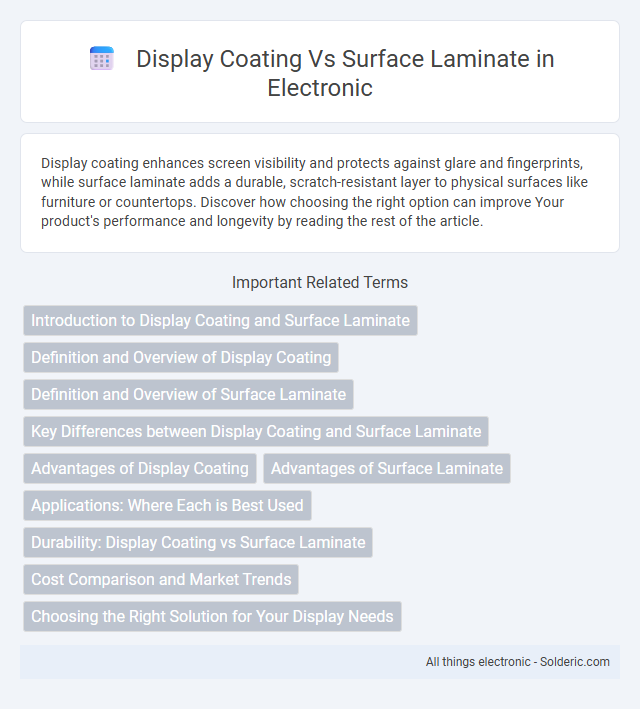Display coating enhances screen visibility and protects against glare and fingerprints, while surface laminate adds a durable, scratch-resistant layer to physical surfaces like furniture or countertops. Discover how choosing the right option can improve Your product's performance and longevity by reading the rest of the article.
Comparison Table
| Feature | Display Coating | Surface Laminate |
|---|---|---|
| Definition | Thin protective or decorative layer applied on display screens | Durable synthetic layer applied on furniture or surfaces for protection and aesthetics |
| Primary Use | Enhances screen visibility, reduces glare, and adds scratch resistance | Protects surfaces from wear, scratches, and moisture |
| Material Composition | Typically polymers, anti-reflective or anti-glare compounds | Melamine resin, paper, or vinyl bonded under heat and pressure |
| Durability | Moderate; designed mainly for electronic screens | High; designed for heavy use and physical impact |
| Application Method | Coating spray, dip-coating, or lamination on screens | Lamination process bonding layers onto surfaces |
| Typical Industries | Electronics, display manufacturing, mobile devices | Furniture, cabinetry, interior design, construction |
| Cost | Generally lower cost for consumer electronics | Varies; often higher due to material and application process |
Introduction to Display Coating and Surface Laminate
Display coating enhances screen visibility by reducing glare and fingerprints through specialized chemical layers, improving your viewing experience and touch sensitivity. Surface laminate provides a protective, durable film applied on furniture or surfaces, offering resistance to scratches, moisture, and impact while maintaining aesthetics. Choosing between display coating and surface laminate depends on whether you need screen performance enhancement or surface protection.
Definition and Overview of Display Coating
Display coating refers to a thin layer applied to electronic screens to enhance visual performance, reduce glare, and protect against scratches. It improves contrast, color accuracy, and touch sensitivity, making your device easier to use in various lighting conditions. Unlike surface laminate, which is a protective film primarily for physical durability, display coatings are engineered to optimize optical properties and user experience.
Definition and Overview of Surface Laminate
Surface laminate is a durable synthetic material used to cover and protect surfaces, often composed of layers of paper or fabric impregnated with resin, bonded under heat and pressure. It provides resistance to scratches, moisture, and stains, making it ideal for furniture, countertops, and cabinetry finishes. Compared to display coatings, surface laminates offer enhanced durability and a wide range of textures and designs for aesthetic customization.
Key Differences between Display Coating and Surface Laminate
Display coating enhances screen visibility, touch sensitivity, and reduces glare through advanced chemical layers, while surface laminate primarily protects surfaces from scratches, moisture, and wear. Display coatings are typically applied to electronic screens and include anti-reflective, anti-fingerprint, and blue light filters. Surface laminates are thicker, more durable layers used on furniture, countertops, and printed materials to ensure longevity and aesthetic preservation.
Advantages of Display Coating
Display coating offers superior glare reduction and enhanced color vibrancy compared to surface laminate, improving screen visibility in bright environments. It also provides better resistance to fingerprints and smudges, maintaining a cleaner and more professional appearance. These benefits make display coatings ideal for high-performance monitors and touchscreens requiring clear and vivid visual experiences.
Advantages of Surface Laminate
Surface laminate offers superior durability and scratch resistance compared to display coatings, making it ideal for high-traffic or frequently used surfaces. Its ability to provide a wide range of textures and finishes enhances aesthetic versatility and design customization. Surface laminate also often delivers better moisture resistance and easier maintenance, ensuring long-lasting performance in residential and commercial settings.
Applications: Where Each is Best Used
Display coating is ideal for high-traffic commercial environments such as retail stores and museums, where protecting screens from glare and fingerprints enhances visibility and user interaction. Surface laminate excels in residential and office furniture applications, offering durable, decorative finishes that resist scratches and moisture. Your choice depends on whether you prioritize screen clarity and protection or surface durability and aesthetic appeal.
Durability: Display Coating vs Surface Laminate
Display coatings offer superior scratch resistance and UV protection compared to surface laminates, enhancing screen longevity in high-use environments. Surface laminates provide moderate durability with decent resistance to abrasion but may degrade faster under prolonged exposure to moisture and heat. Choosing display coating over laminate ensures better preservation of visual clarity and device aesthetics over time.
Cost Comparison and Market Trends
Display coatings generally incur higher costs than surface laminates due to advanced materials and application technologies used for enhanced durability, anti-glare, and fingerprint resistance. Market trends indicate a growing preference for display coatings in premium electronics, driven by consumer demand for better screen clarity and touch sensitivity, while surface laminates dominate cost-sensitive industries like furniture and cabinetry. Economies of scale and production advancements are gradually narrowing the cost gap, promoting increased adoption of coated displays in mid-range devices.
Choosing the Right Solution for Your Display Needs
Display coating enhances screen clarity and reduces glare by applying specialized chemical layers directly to the glass, ideal for high-definition and touch-sensitive devices. Surface laminate offers a protective film that guards against scratches and fingerprints, perfect for environments demanding durability and easy maintenance. You should evaluate your display's usage environment and desired lifespan to choose between the optical benefits of coatings and the robust protection of laminates.
Display Coating vs Surface Laminate Infographic

 solderic.com
solderic.com